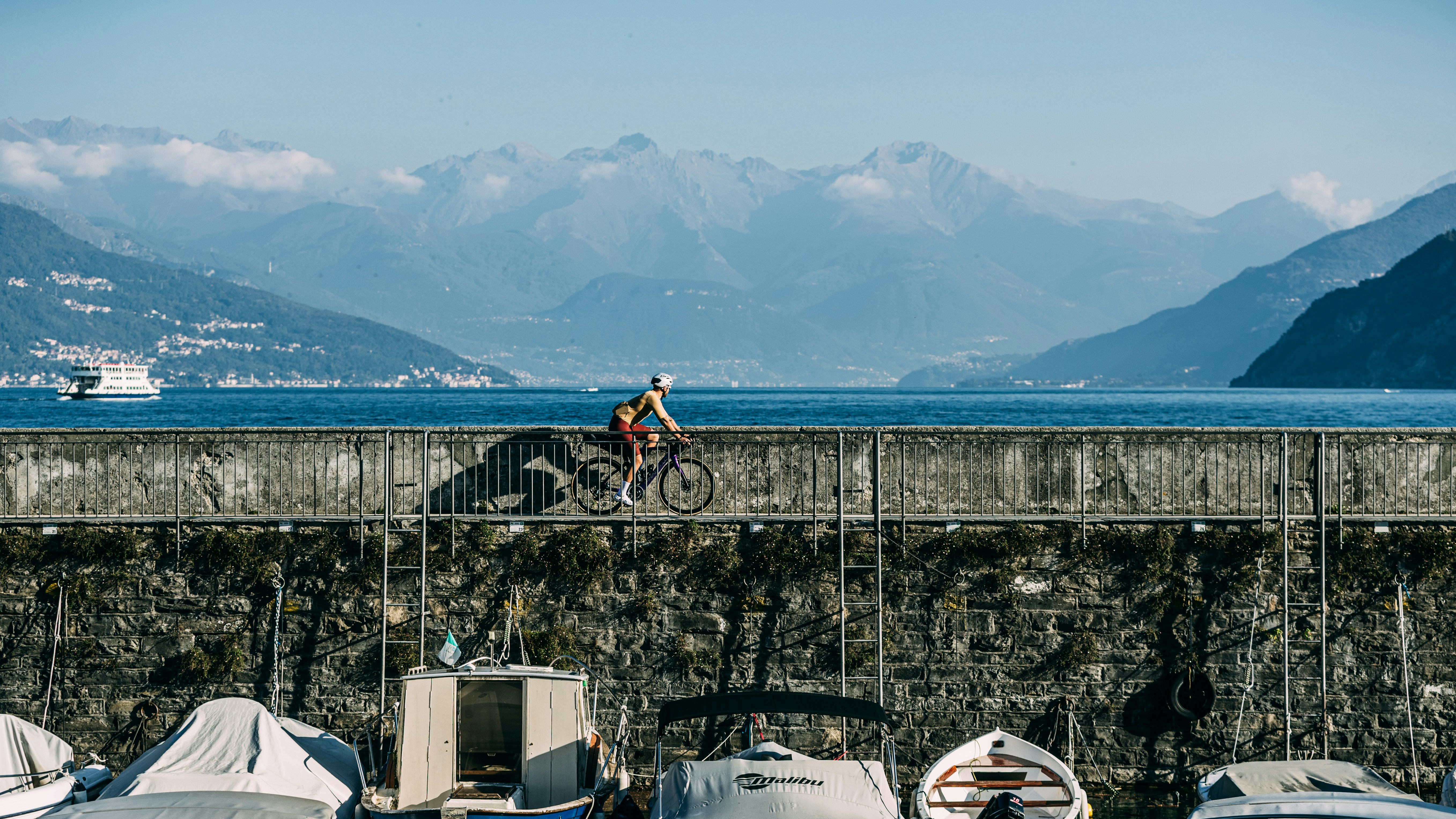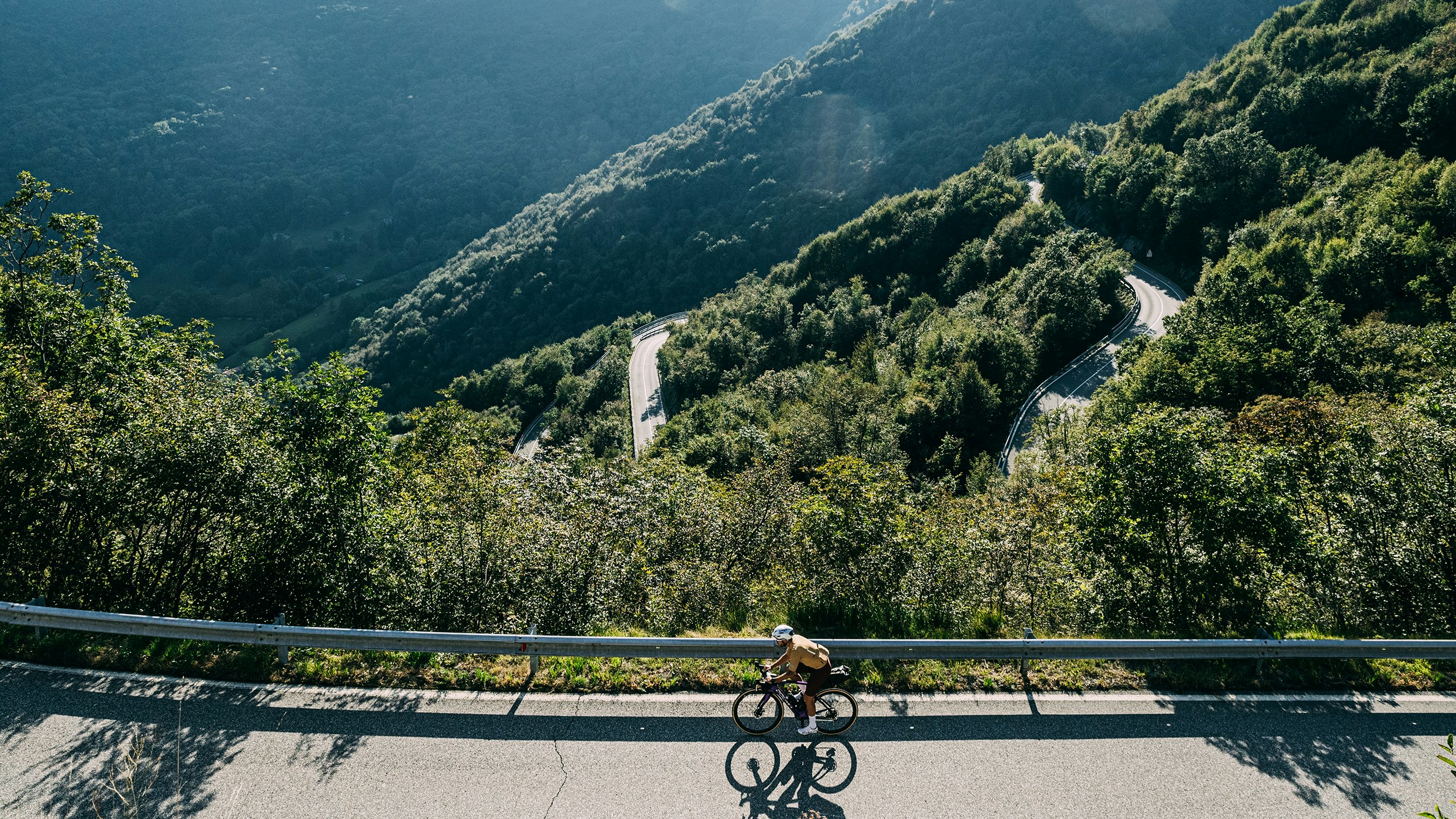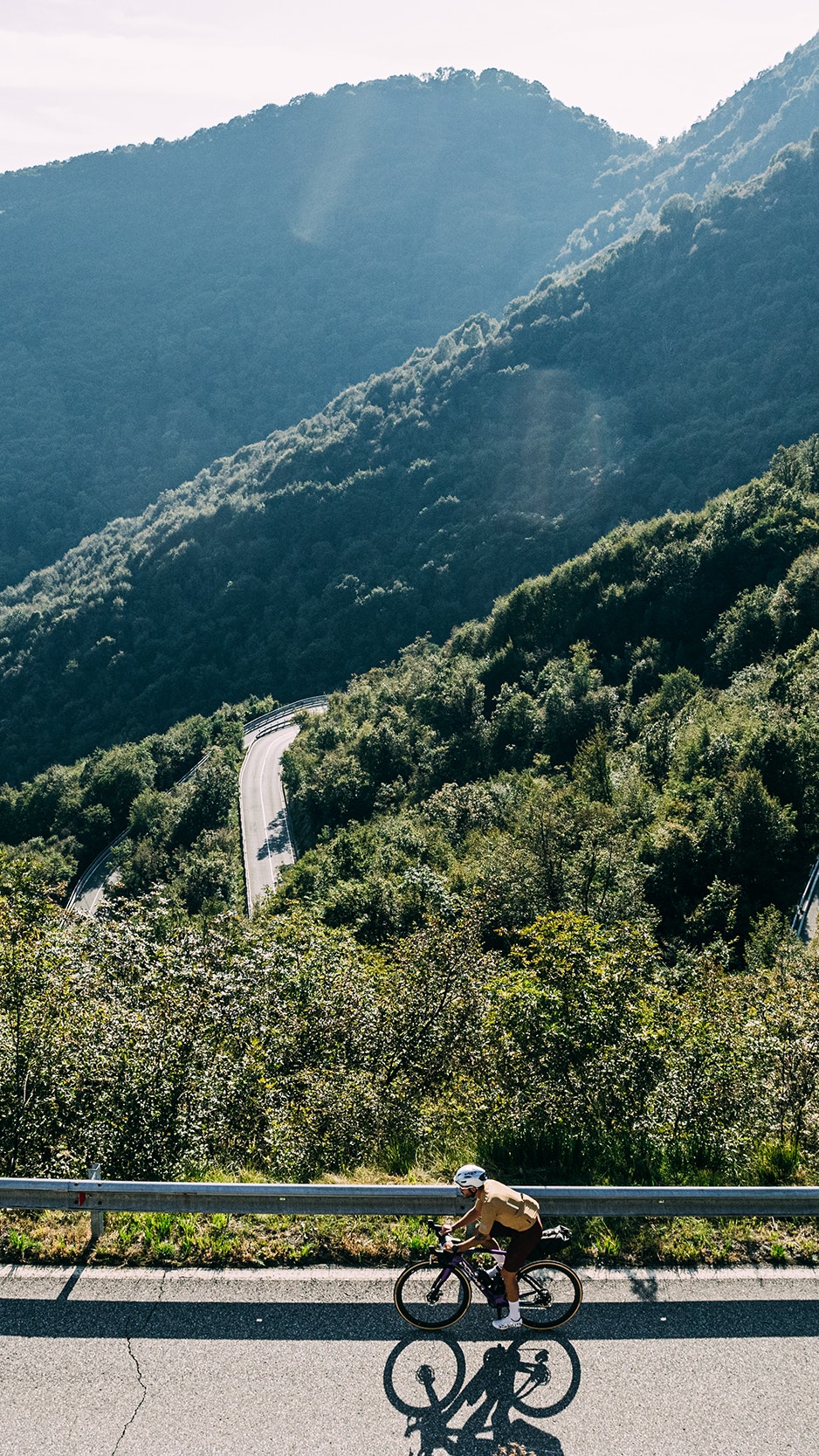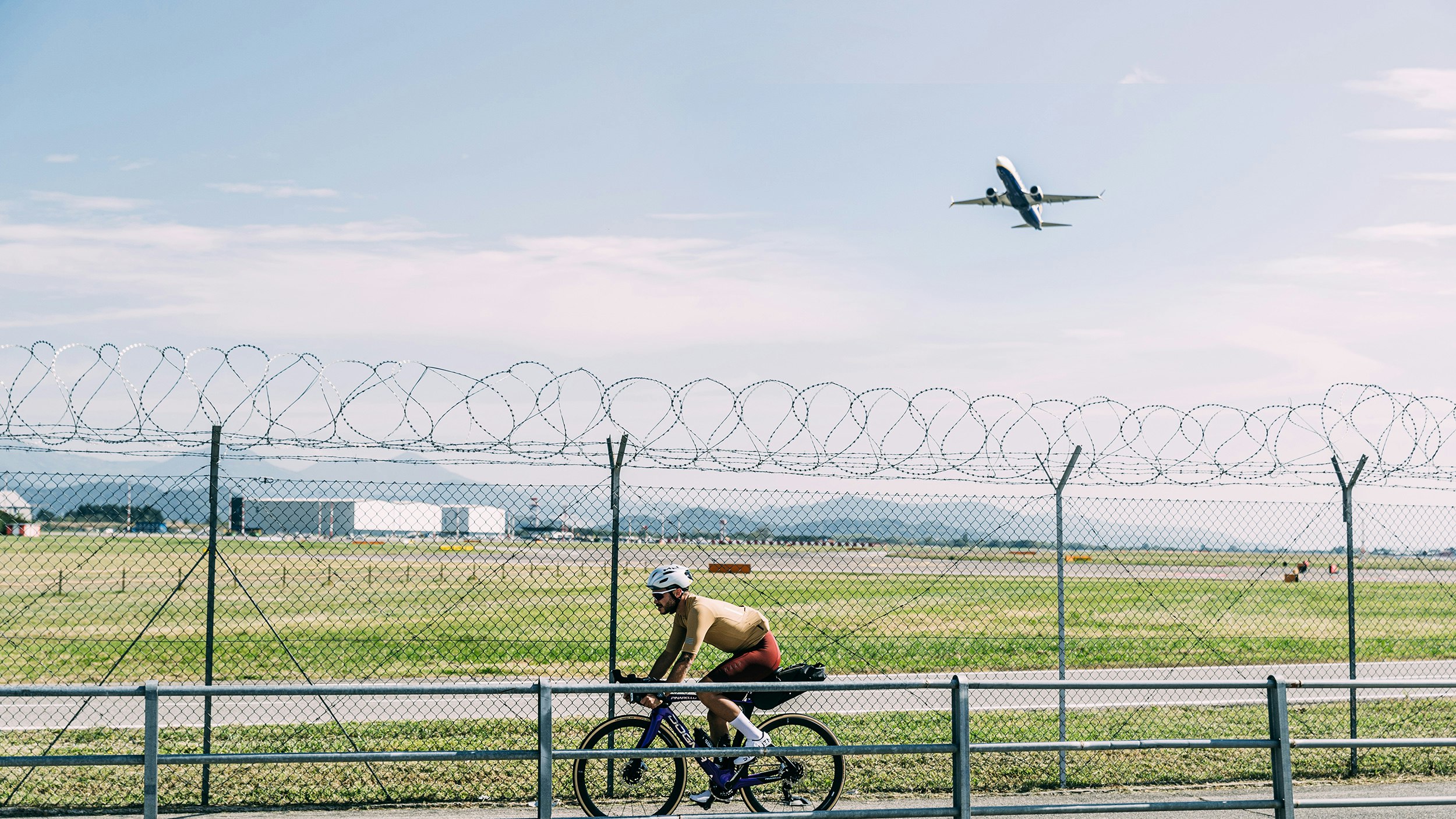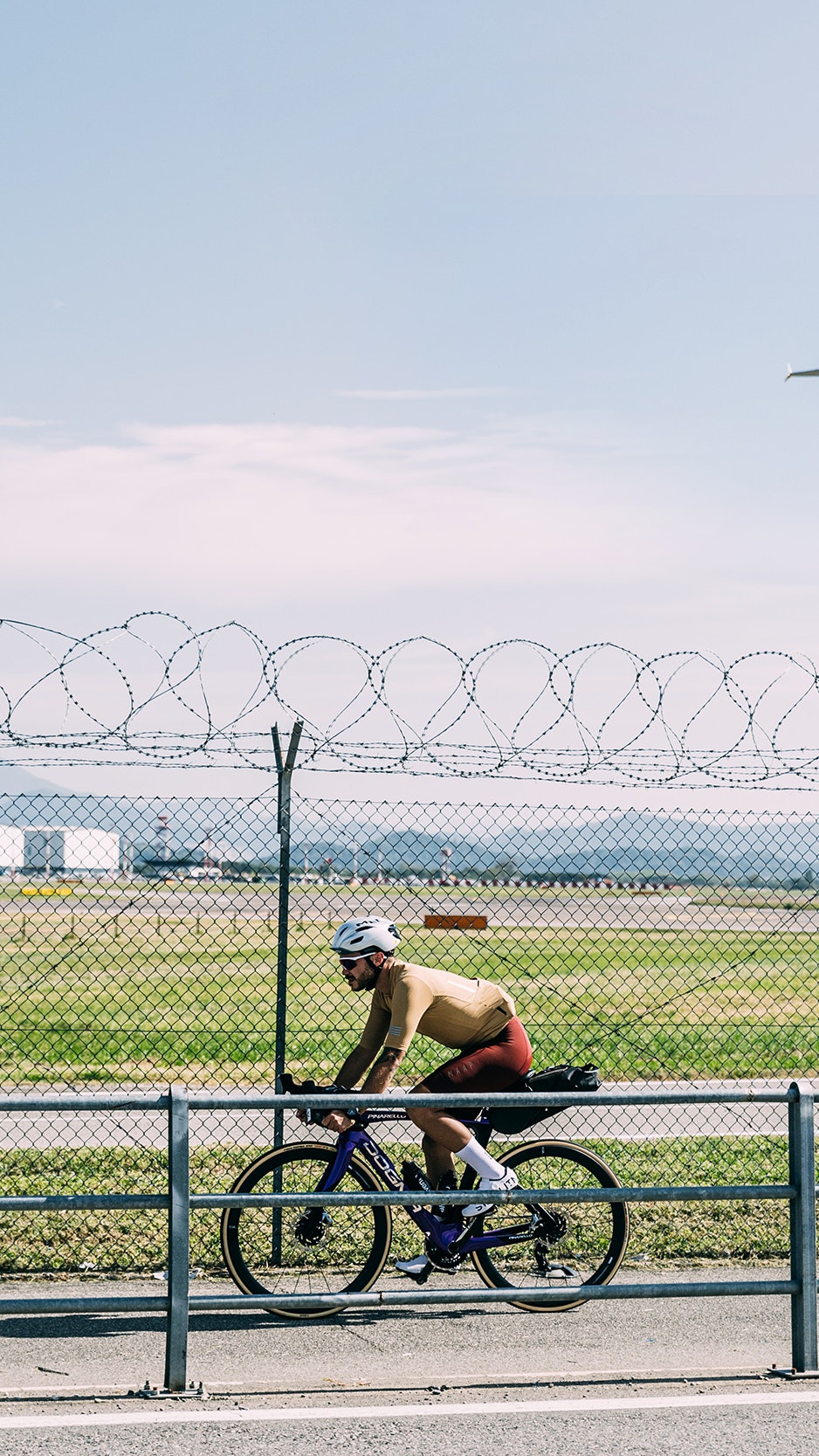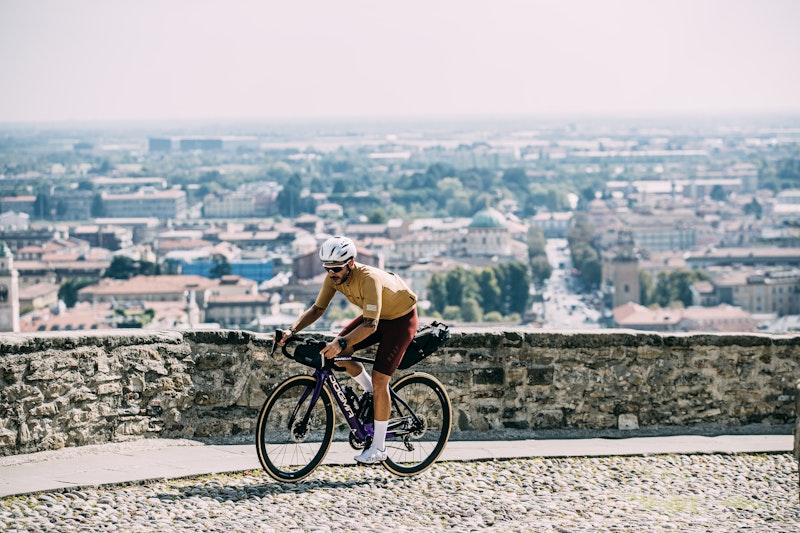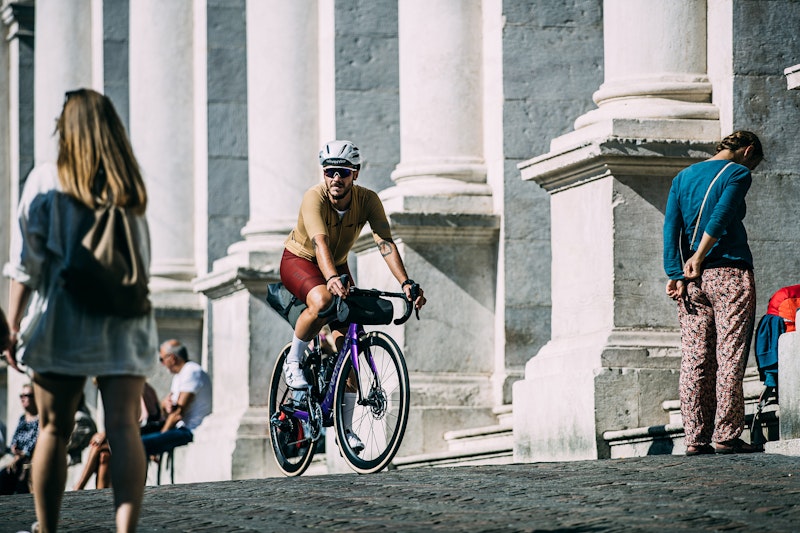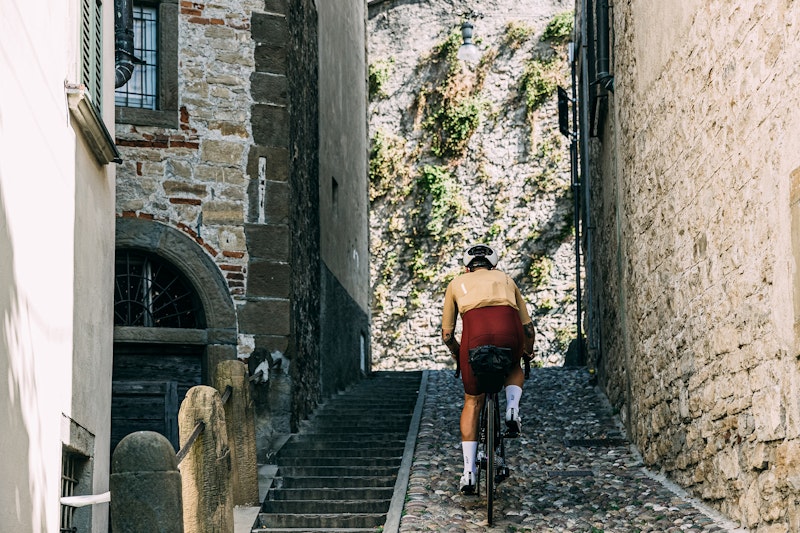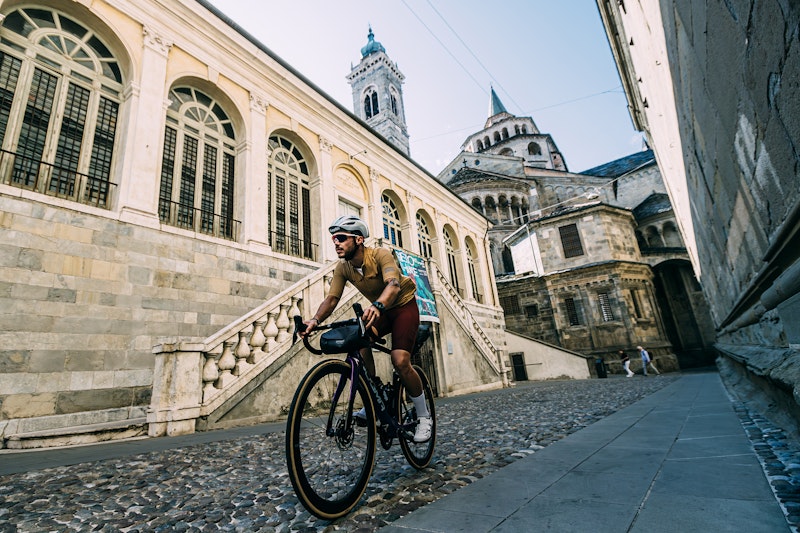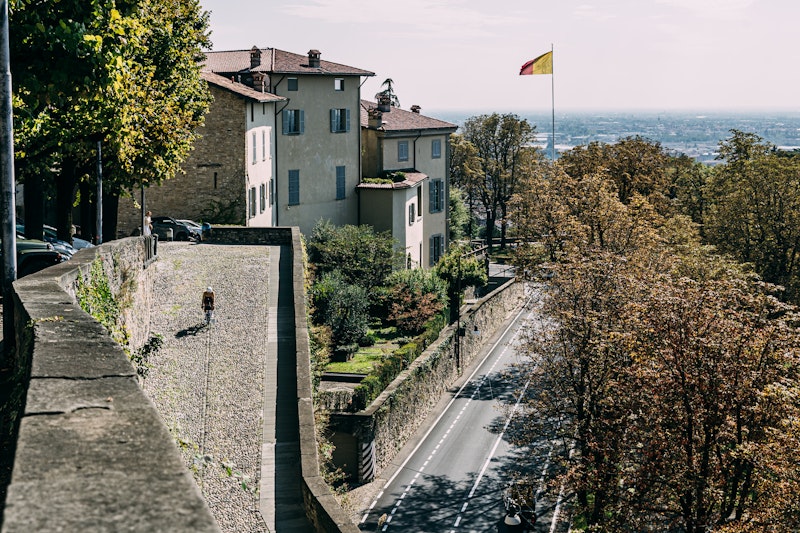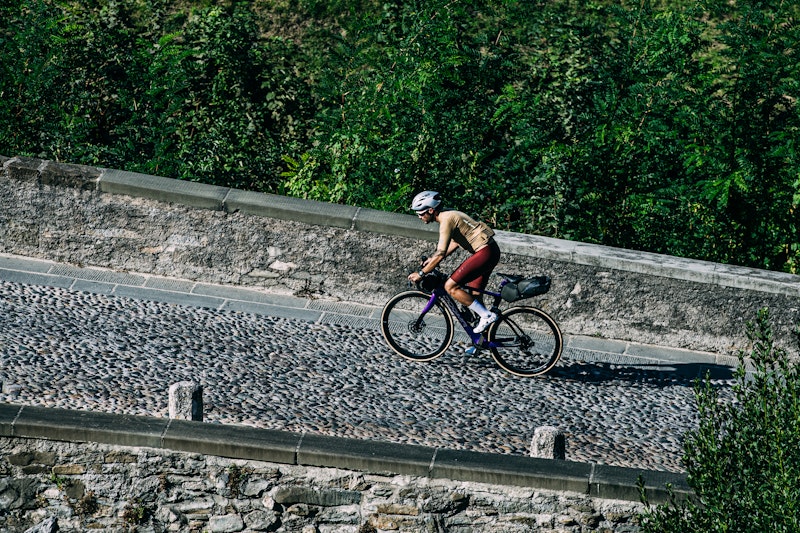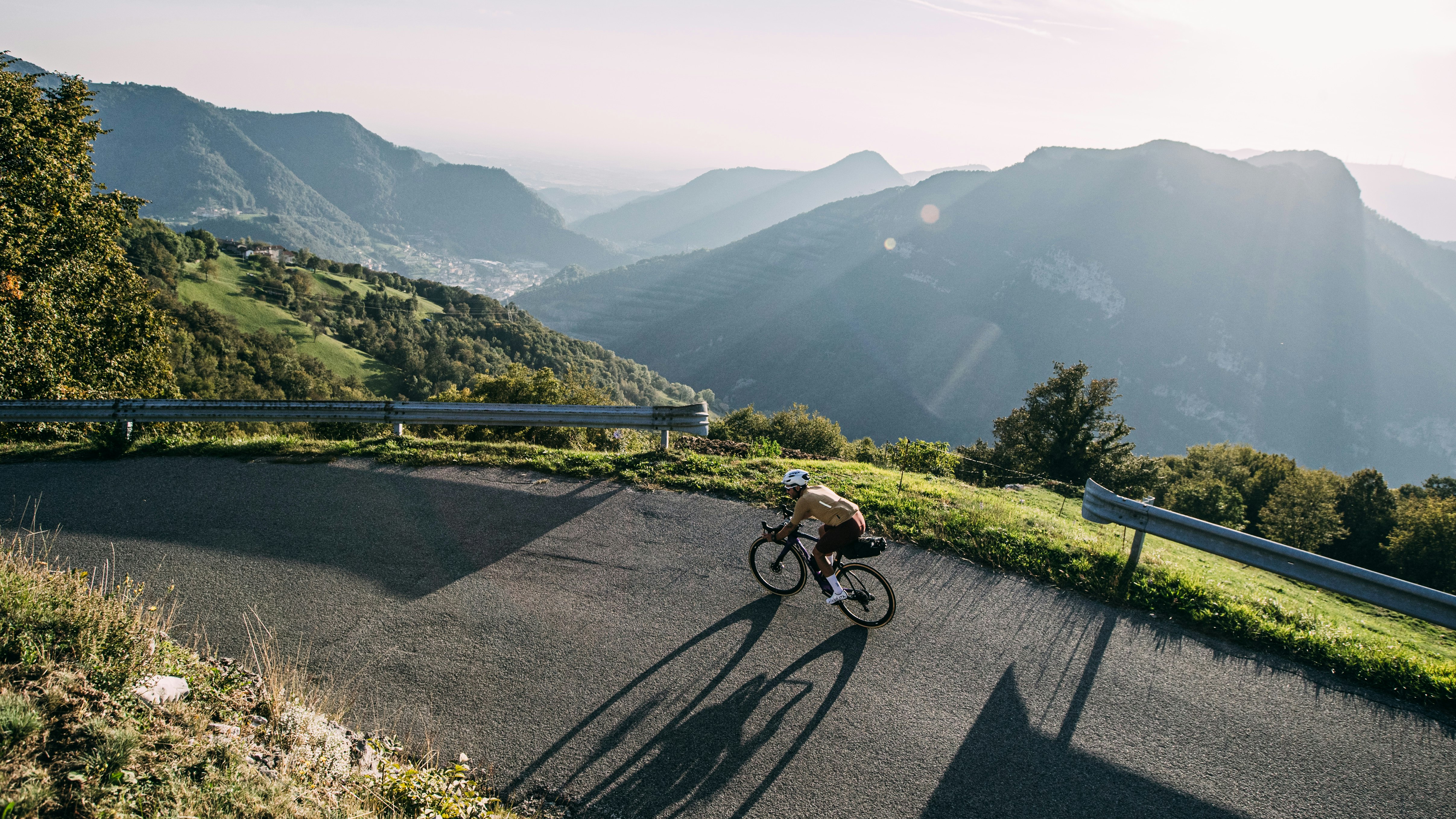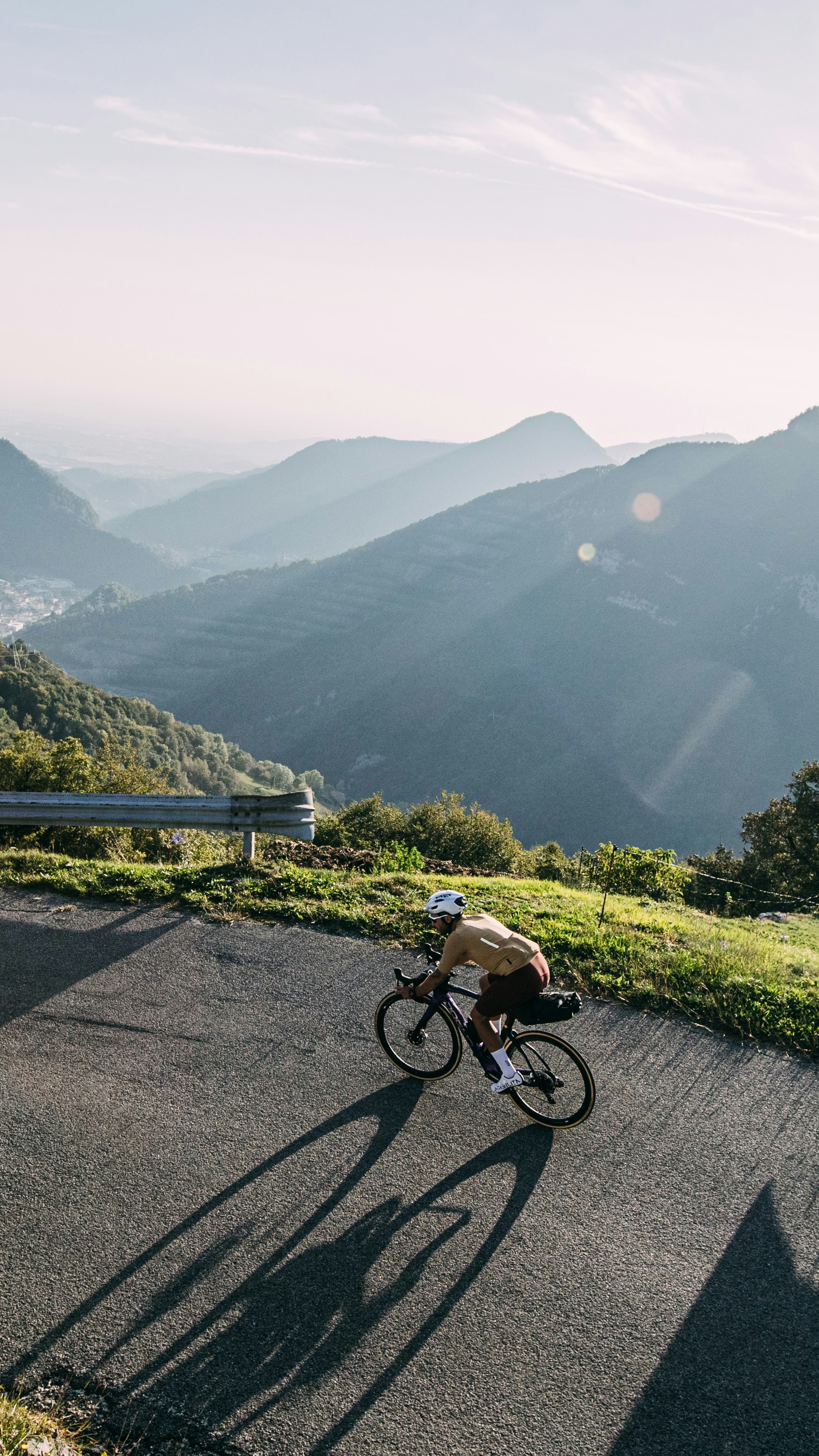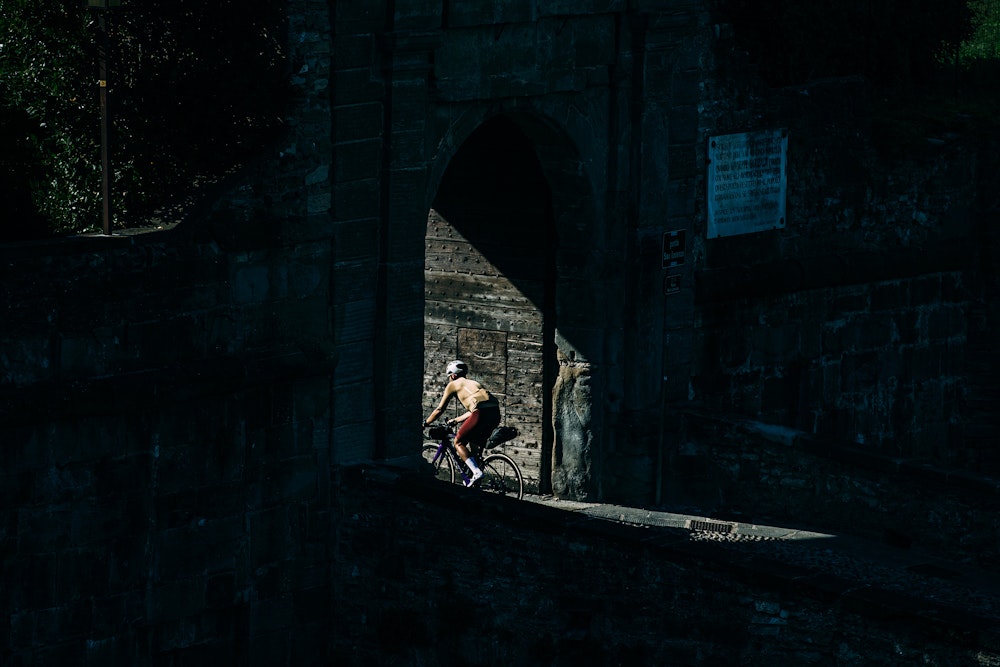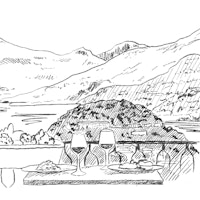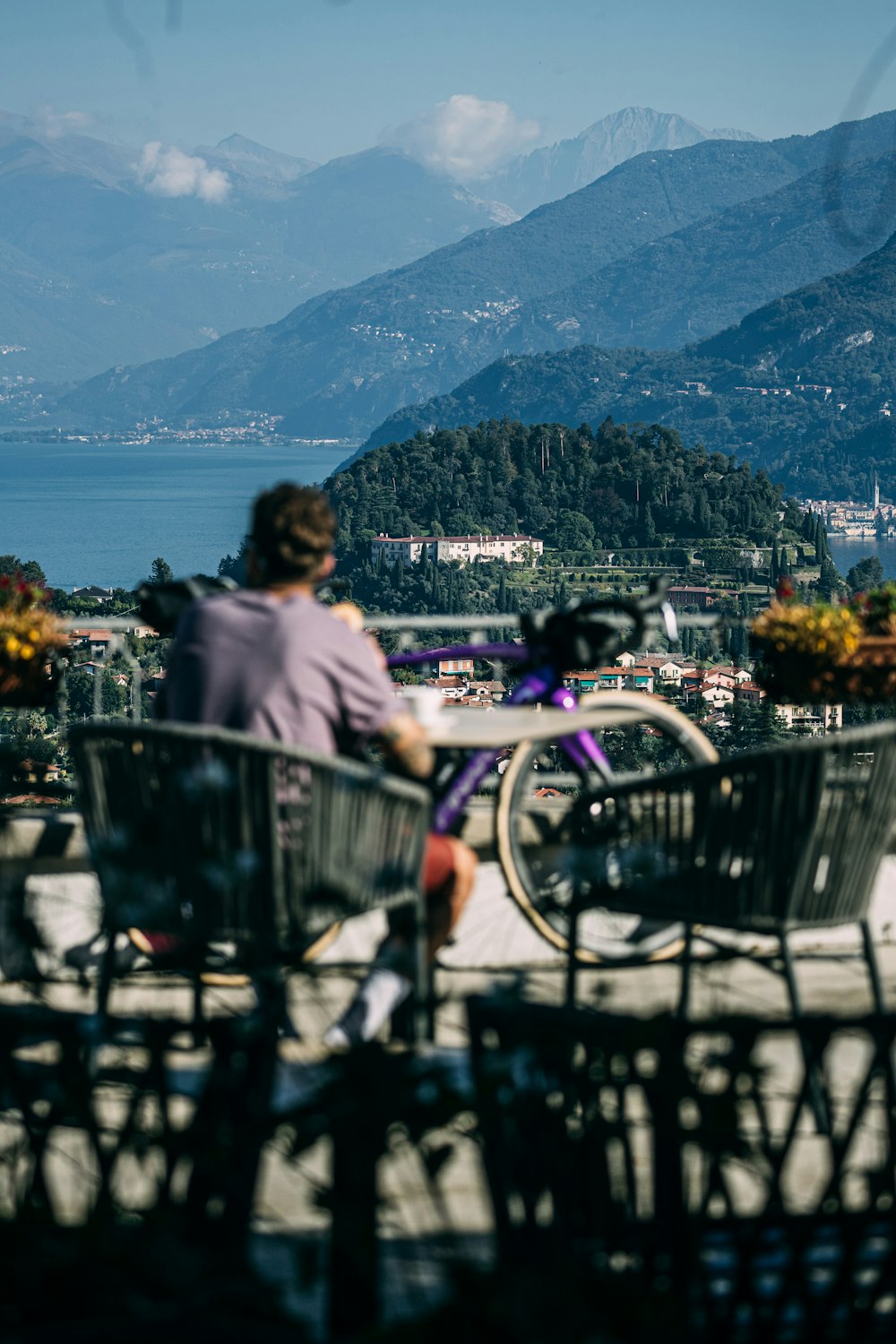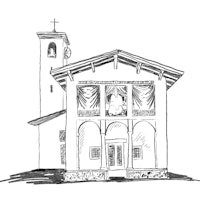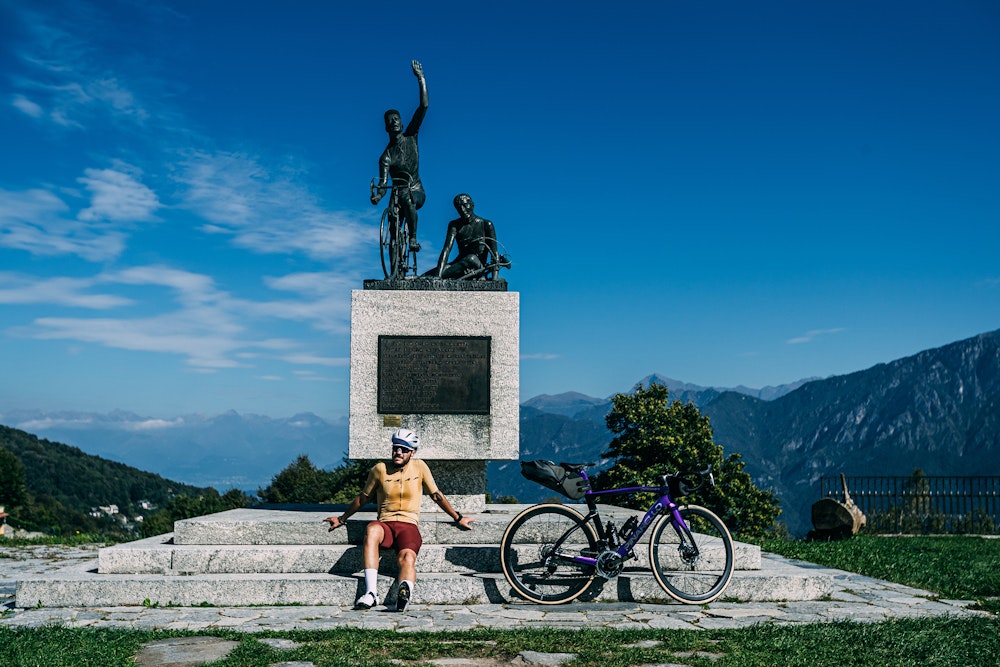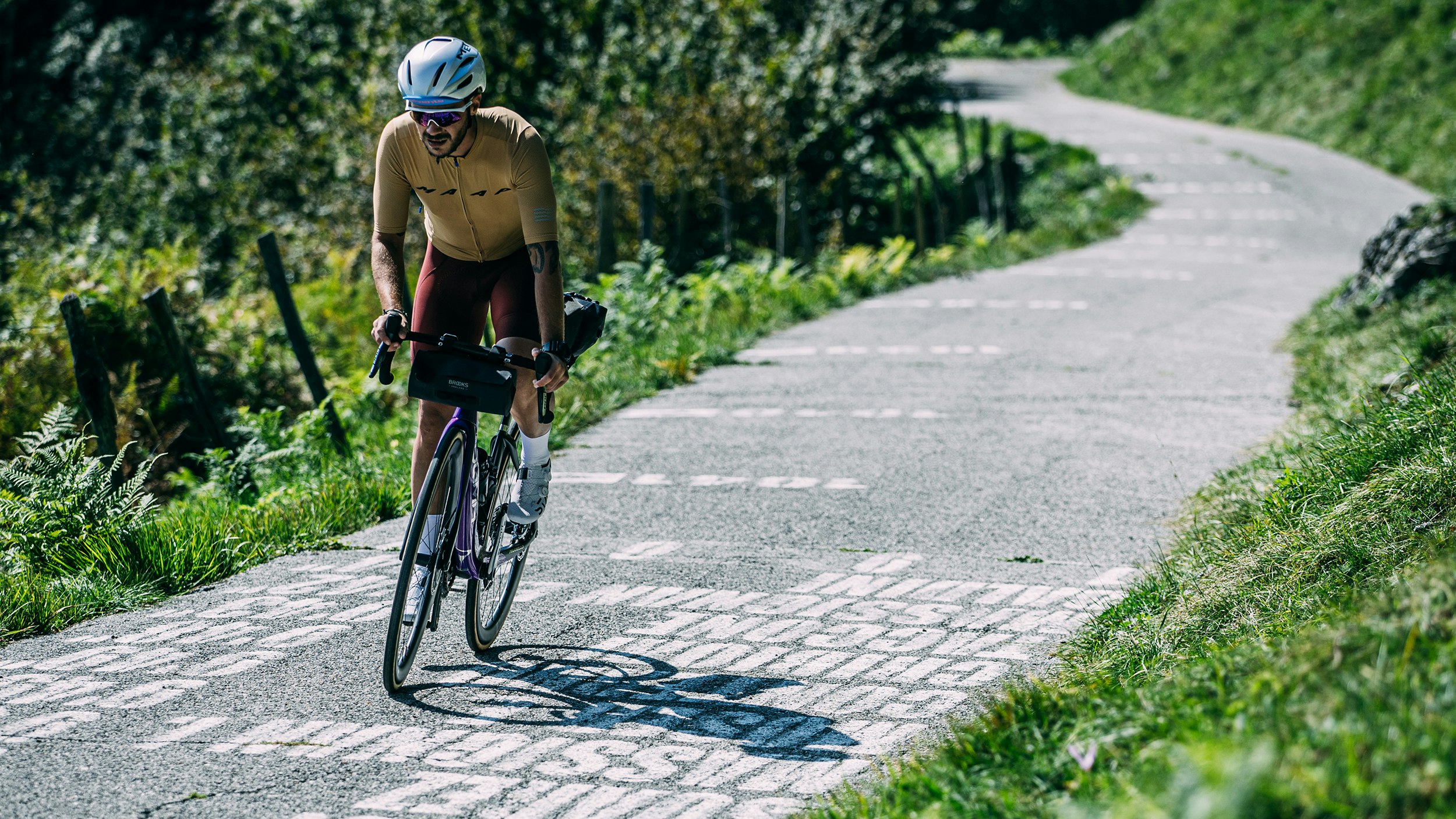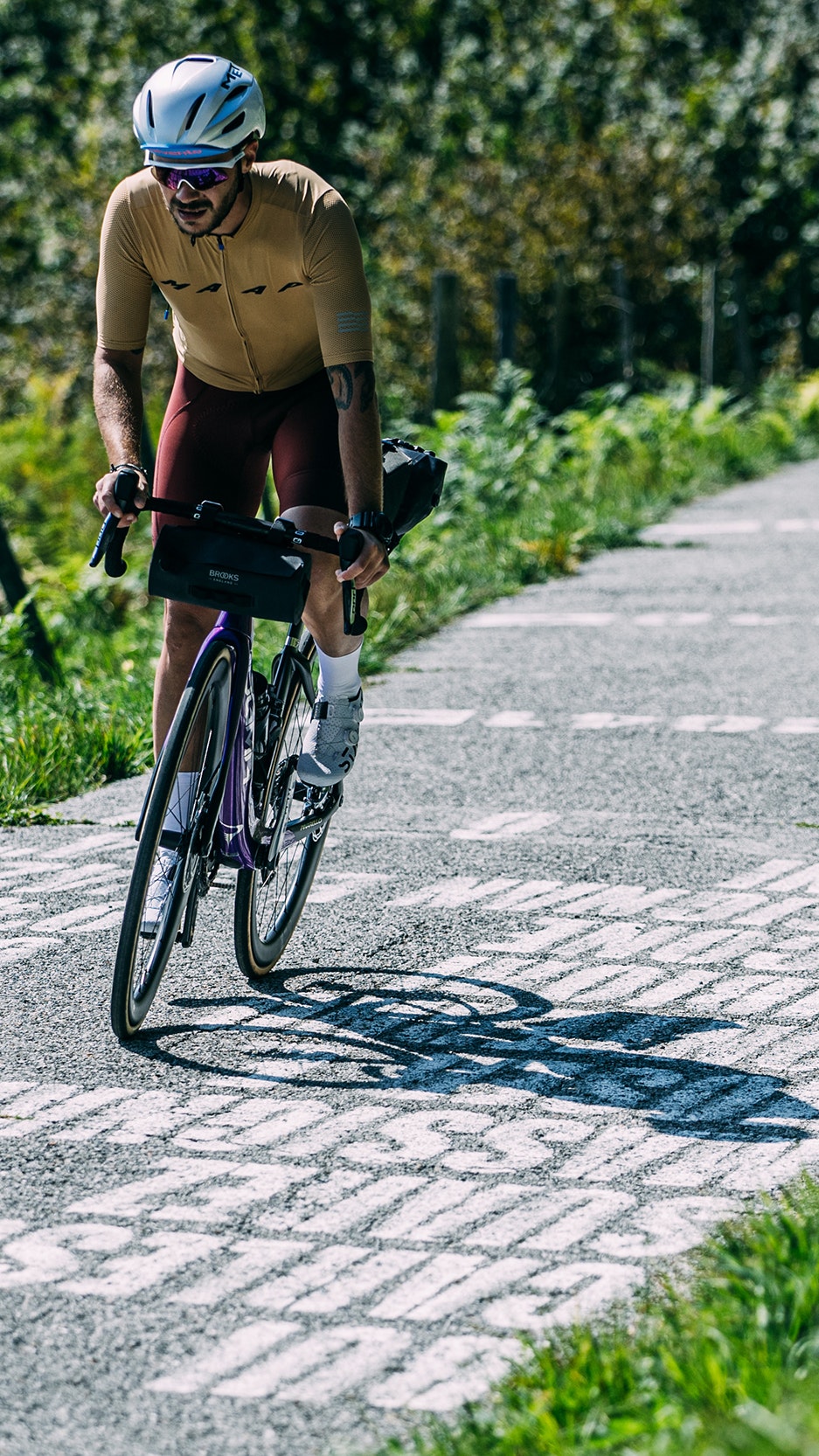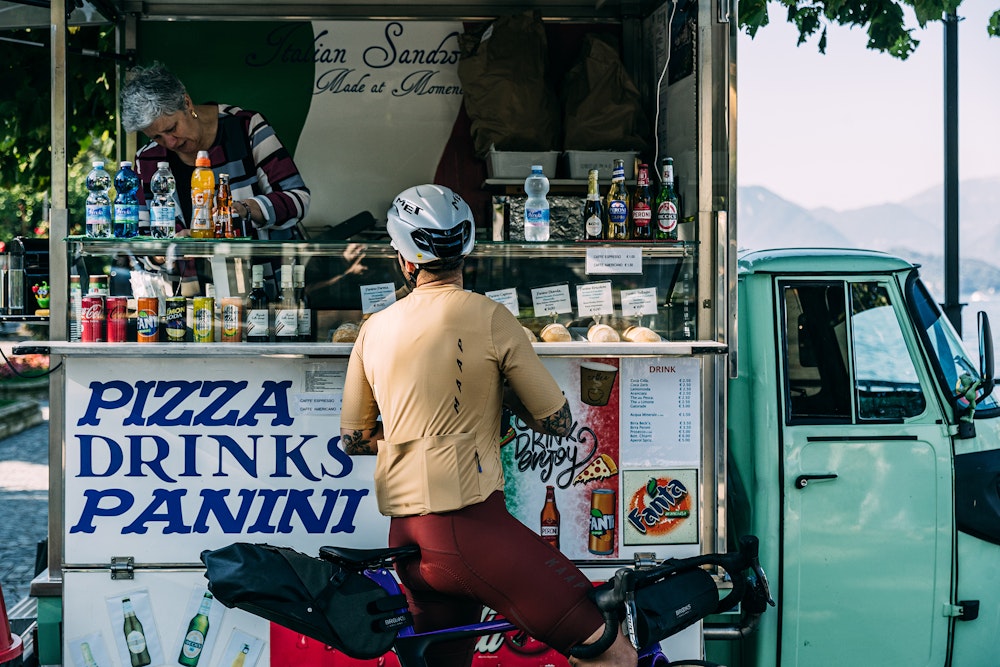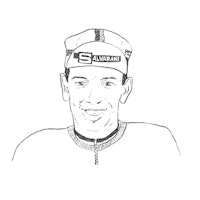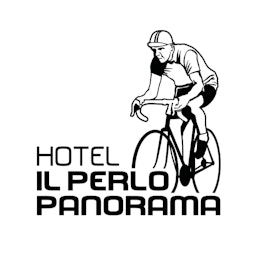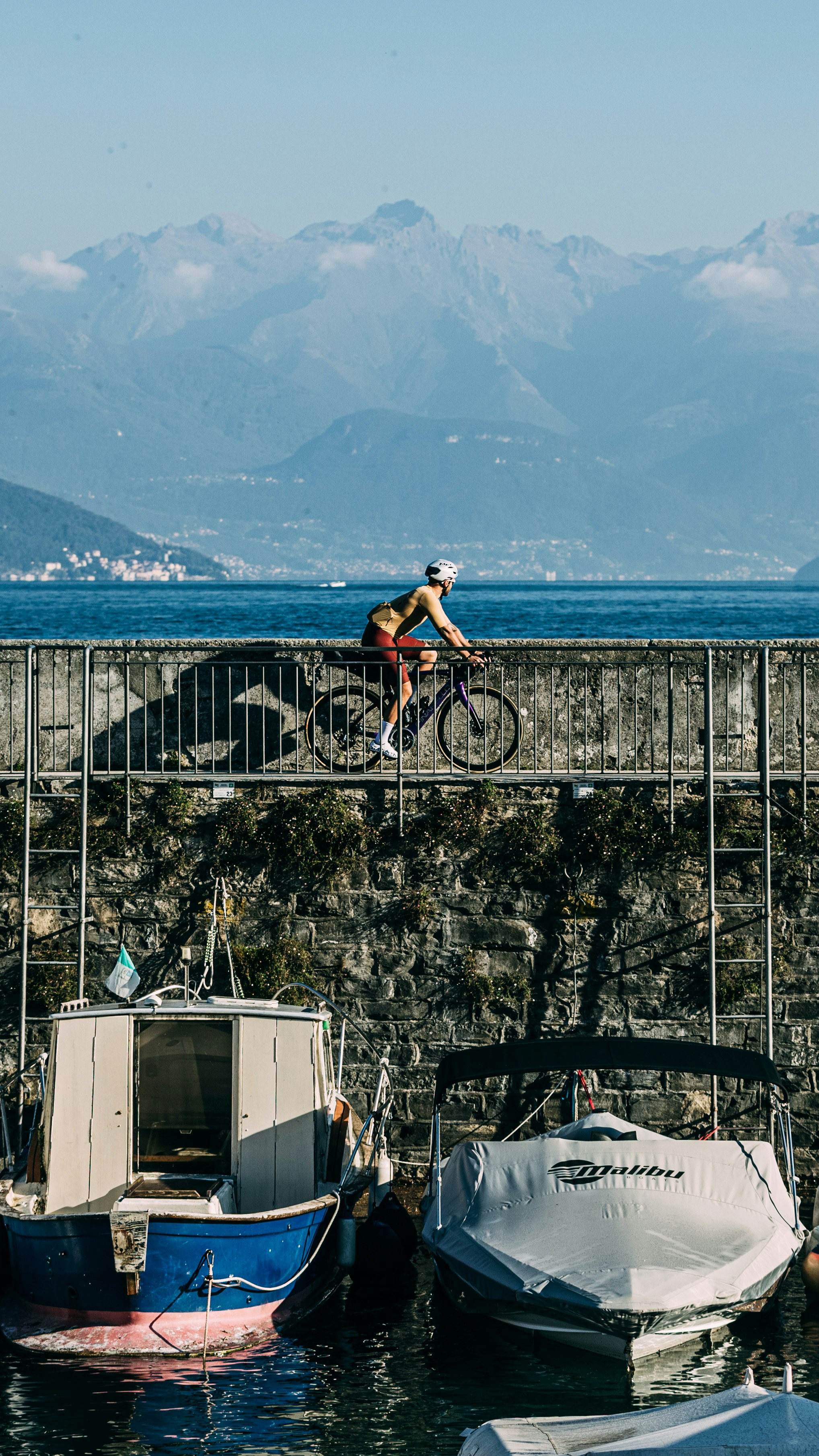
Dreaming of the Giro di Lombardia
From Bergamo to Lake Como along the roads of a Cycling Monument.
Period
Jan - Dec
Elevation difference
5.378 m
Total Length
288 km
Duration
3/4 Days
M
Dreaming of the Giro di Lombardia
00
Intro
01
Towards the Lake District of Lombardy
02
Ascents like pilgrimages
03
Up and down the Orobie, great cycling terroir
One has arrived from Brussels-Charleroi, another from Dublin, the third from Zurich. The last to join them just got off the flight from Barcelona El Prat. They are, unequivocally, four cyclists. You can tell from the fact that, in addition to their light hand luggage, they carry large black bags containing their racing bikes. They greet each other warmly and make their way to the airport’s Bike Room. A few minutes later they emerge fully dressed in cycling attire, walking their neatly reassembled bicycles. In seeing them, perhaps some present-day cycling enthusiasts have recognised them. They are four former professionals: the Belgian Philippe Gilbert, the Swiss Oliver Zaugg, Ireland’s Daniel Martin and Spain’s Joachim Rodriguez, best known as Purito. For six consecutive seasons they have put their names in the hall of fame of the Giro di Lombardia, one of the oldest and most prestigious international cycling races, the fifth Classica Monumento of the season: Gilbert in 2009 and 2010, Zaugg in 2011, Purito in 2012 and 2013 and Martin in 2014. And now they have taken a weekend off to cycle, as friends, on those same roads that, more or less ten years ago, saw them triumph in the fifth Classica Monumento of the season. As they leave the airport, we see them smiling and climb onto their saddles and turn right towards the cycle path that connects the terminal with the centre of Bergamo...
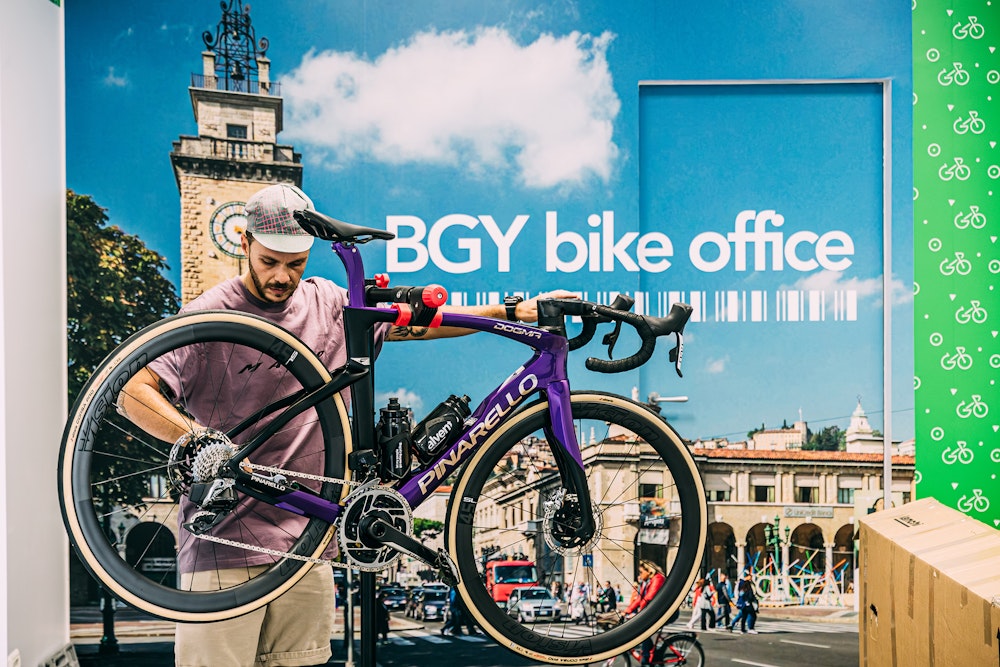
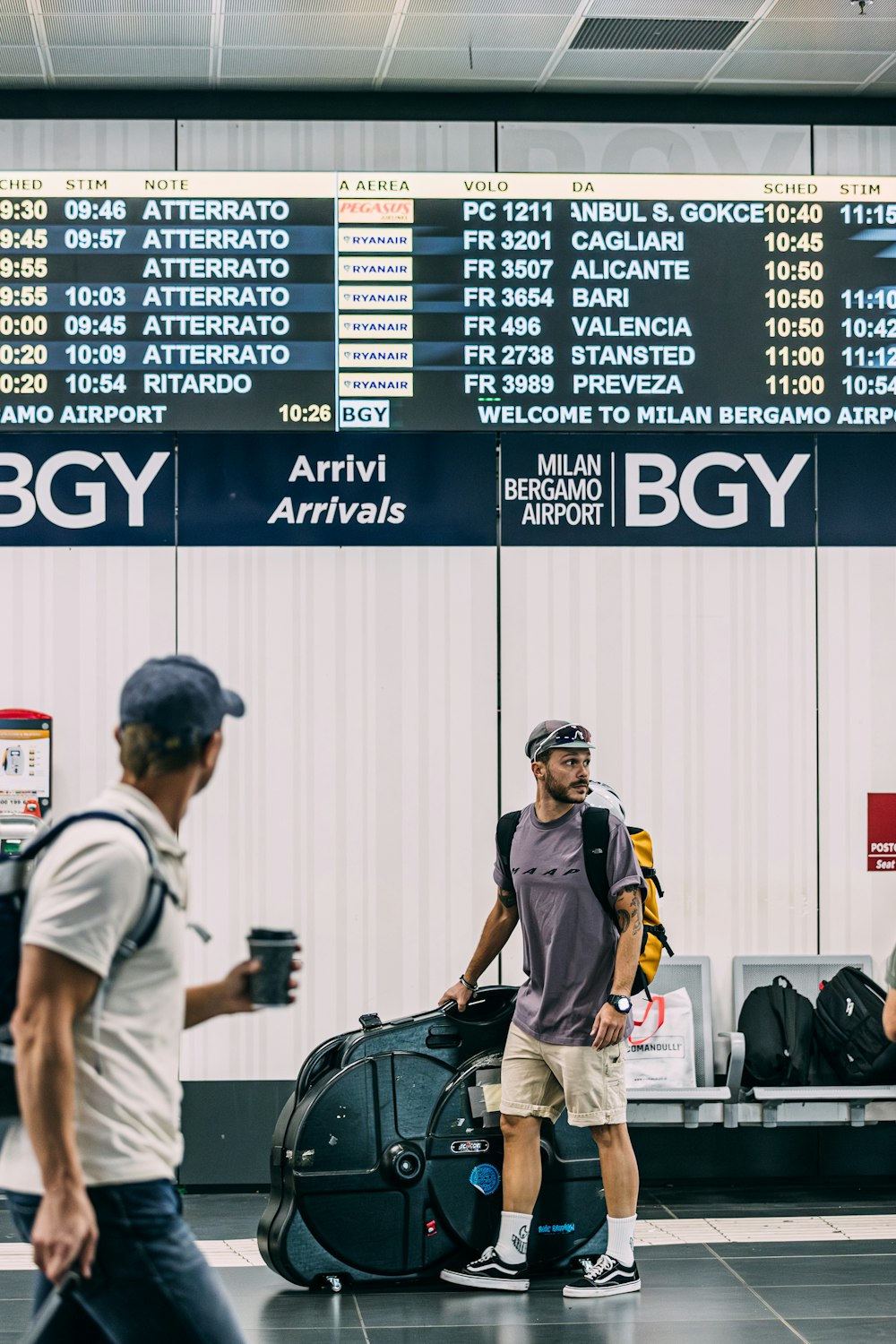
Is that how the story goes? Well, not really, to be honest. It’s not the four former champions from four different corners of the Old Continent but, more modestly, a willing team from the Alvento publication – a cyclist, a photographer and a writer – who designed this Destination on the roads between Bergamo and Como that made the history of the Classica delle foglie morte. Incidently, there’s not so much in the way dead leaves and autumn: in this end of September 2023 it feels like we are still in the warm and bright tail end of summer…
This fanciful opening was just to highlight a concept. The Milan Bergamo Airport (or, if you like, the Caravaggio), Europe’s first bike-friendly airport, is a perfect starting point for those who bring their bike from afar want to follow in the tracks of the great cycling champions and, in particular, on the roads and landscapes of the Giro di Lombardia. In fact, from 2014 onwards – the very year Daniel Martin triumphed, with a sprint in the last kilometre to get ahead of his breakaway companions – the classic has always been held on a route starting in Como and finishing in Bergamo, or vice versa, in alternate years.
So, off we go. We too set off. We planned our ride in five stages, although in fact the full days of cycling are the three in the middle, as we’ve reserved a few hours of the first and last days for the transfer from Orio al Serio airport to Città Alta, and vice versa.
The cycle path that takes us to the city is short and mainly on a protected road: you have to be careful at some crossings and some busier sections when you leave the track. It is certainly not the most fascinating part of the track we’ll be cycling in the next few days, but from the train station onwards you will have the beauty and elegance of Bergamo to welcome you: first with a sequence of wide and elegant boulevards – Viale Papa Giovanni XXIII, Viale Roma, Viale Vittorio Emanuele II – and then with the ascent into the Città Alta, through Porta Sant’Agostino and Viale delle Mura. In the evening we had a lovely walk along the streets of the historic centre: via Porta Dipinta, via Colleoni and Piazza Vecchia, the city’s illustrious piazza. Spritz and dinner, but without overdoing it and without staying up too late, as the next day a wonderful crossing of Lombardy awaited us along some hilly country roads.
As dawn breaks, a hearty breakfast and we’re off on quick ride to Lake Como. In the morning, the viale delle Mura overlooking the plain catches our eye, but if we start paying too much attention to the scenery, we’ll never get to destination. We descend from Città Alta, leaving the S. Vigilio hill to our right, and exit Bergamo in the direction of Curno. At Ponte S. Pietro we cross the course of the river Brembo and go straight on to Terno d’Isola. We keep the Prealpi as a reference, to the north, on our right. After crossing Villa d’Adda, the last town in the province of Bergamo, we descend to the furrow of the river and beyond the bridge we get to Imbersago, on the right bank of the Adda and in Brianza. From Calco we begin to climb with regular gradients towards Colle Brianza. The road runs along the coast: on our right, the furrow of the Adda valley, which widens to form the lakes of Olginate and Garlate; on the left, the lakes of Annone and, a little further away, that of Pusiano. We have entered the Lake District of Lombardy and, from now on, these bodies of water will faithfully keep us company.
After descending to Galbiate, we go around the pyramid of Mount Barro on the left and, beyond Civate, from Valmadrera. From there onwards we begin to skirt «that particular arm of Lake Como, which, reaching towards the south, between two uninterrupted mountain chains, finds its shore-line broken by projecting spurs into a constant succession of bays and creeks, contracts at length quite abruptly…». In the end, whether we like it or not, we have to agree with Manzoni: this narrow arm of the lake does resemble a river, or at least a fjord. To remind us, however, that these latitudes are not northern, we need only look up from the road and see the shores cultivated with olive trees. Meanwhile, on the opposite side of the lake, the Pian dei Resinelli and the rocky profile of the Grigne appear as in a film sequence. We arrive at Bellagio and the reward at this first stop is there in front of us: the resounding beauty of a place that looks like the deck of a ship about to set sail for the Alps and northern Europe. Bellagio, dotted with majestic villas and century-old parks, has for hundreds of years been an elective place of delight for Lombard aristocrats, then for the most exclusive European nobility and today, in particular, a much-loved destination for wealthy Americans travelling the world: it’s enough to consider that, out of aspiration, one of the most famous resorts in Las Vegas is itself called The Bellagio, freely inspired by the architecture of the neoclassical Villa Serbelloni. We will not be sleeping there, but in a place that has nothing to envy in terms of location, charm and warmth: the Perlo Panorama.
It wasn’t easy to set off: we were tempted to make it our base camp for daily lakeside randonnées and return every evening to be pampered by Perlo’s hospitality and views. But it didn’t seem right to keep Her waiting... Our Lady of the Cyclists. At the top of today's first climb, which we tackled practically as soon as we got out of bed, the Sanctuary of the Madonna del Ghisallo was expecting us, a place of true devotion for all of us worshipers of the two wheels. The ascent to Ghisallo from Bellagio follows the classic route, the one tackled dozens of times in the history of the Giro di Lombardia and which has often determined the outcome of the whole race. Just to give an example, Fausto Coppi, who won the Giro della Lombardia five times, was the first to reach the top on four consecutive occasions, (1946-50); and before him Alfredo Binda had done the same, three times out of four (1924, 1925 and 1926) and Gino Bartali, two out of three (1936 and 1940). Of course, much depended on where on the route the climb was to come, but often, and even more so in recent years (see Rominger in 1992 and Bettini in 2005), Ghisallo has been the crucial test for great victories.
The climb sets off quite aggressively, with a series of short hairpin corners and steady gradients between 8 and 9%, with peaks of 12%. Then it flattens out between Guello and Civenna, returning to around 8% in the last two kilometres. It’s less than ten kilometres in total, for a positive height difference of 567 metres.
Statistically nothing major, but one gets a powerful sensation treading in the footsteps of the great champions, those you have seen immortalised dozens of times, perhaps in black and white photos, along dusty roads or in the rain and mud. It’s a question of fitting one’s self in the epic frame of cycling, as well as in the landscape of one of the most spectacular panoramas of northern Italy, between mountains and lake. At the top, as we have already said, a blessing and a reward await us. The first, whether you’re a believer or not, we receive it in the chapel of the Beata Vergine del Ghisallo; the second, next door, in the beautiful Museo del Ciclismo, on a terrace overlooking the lake and facing the ridges of the Grigne.
At the top of today's first climb, the Sanctuary of the Madonna del Ghisallo was expecting us, a place of true devotion for all of us worshipers of the two wheels.

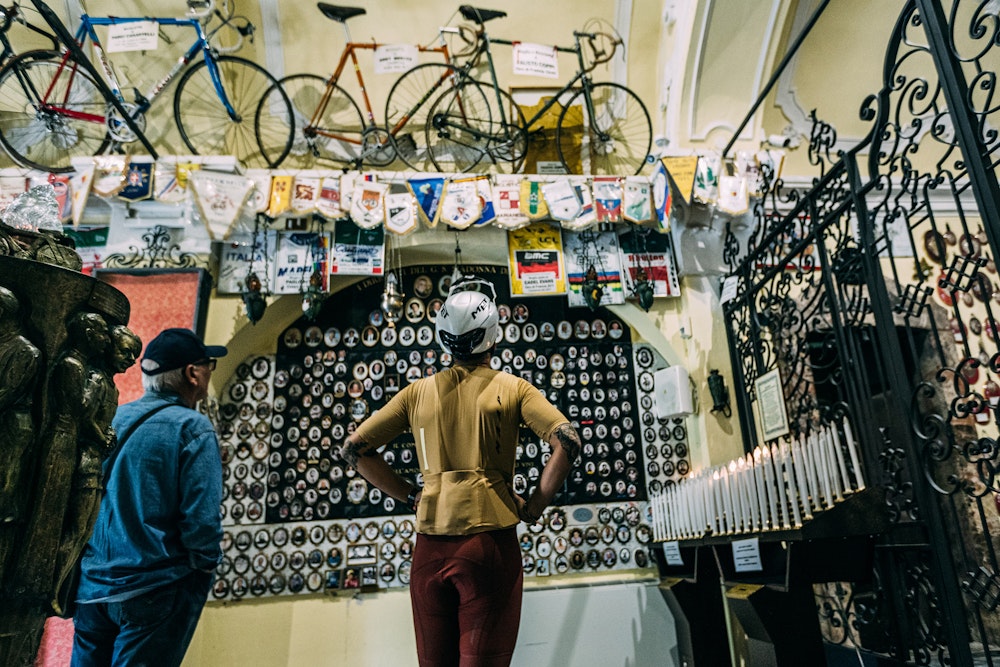
We knew this. Ghisallo was to be but the first taste of the day, as far as ascents go. But perhaps we didn’t remember that the Muro di Sormano really is as steep as a wall. From Magreglio we descend for a stretch along the Valassina road and, after Lasnigo, where we’re greeted on the right by the beautiful little Romanesque church of S. Alessandro towering on a hill, we turn right again at a fork in the direction of Canova and then, to the right again, for the hamlet of Gemù. A series of hairpin turns takes us among the houses of Sormano and all is good so far. But at the end of the village here’s the ominous drizzone: it’s only two kilometers, but the average gradient never drops below 14 percent, with dramatic peaks of 21 in between and, toward the end, 19 percent again. Fortunately, the ordeal is intense but brief. At the top of the Colma di Sormano we can finally breathe again. There is also a restaurant, but it’s not a good idea to stop now and lumber ourselves before the long descent that takes us back to the lake, this time on the other arm. First, though, we enjoy the panoramic opening of the 1.000-meter Pian del Tivano: but if you happen to get here on a public holiday, just beware of all the motorcycles that rumble at high intensity in these parts. From Nesso to Como it’s a string of delightful villages overlooking the lakeshore: if you’re not going too fast as you pass through Torno, check out a fantastic late 16th-century villa, the Pliniana, named after the Latin writer, and Como native, Pliny the Younger, who first described the weird phenomena of an intermitting water spring that gushes from a spot in the mountain nearby.
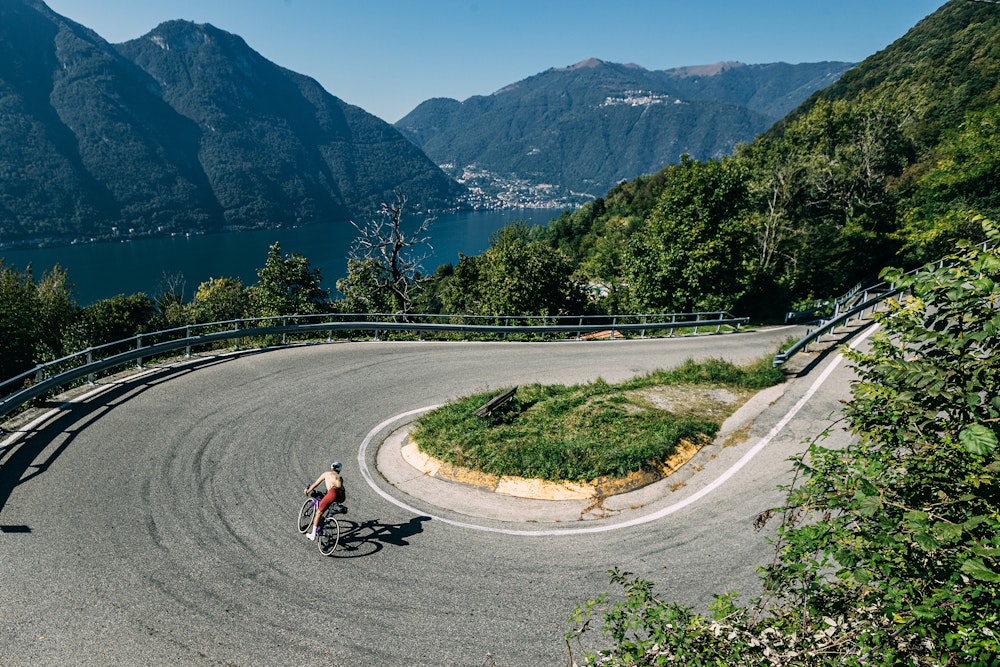
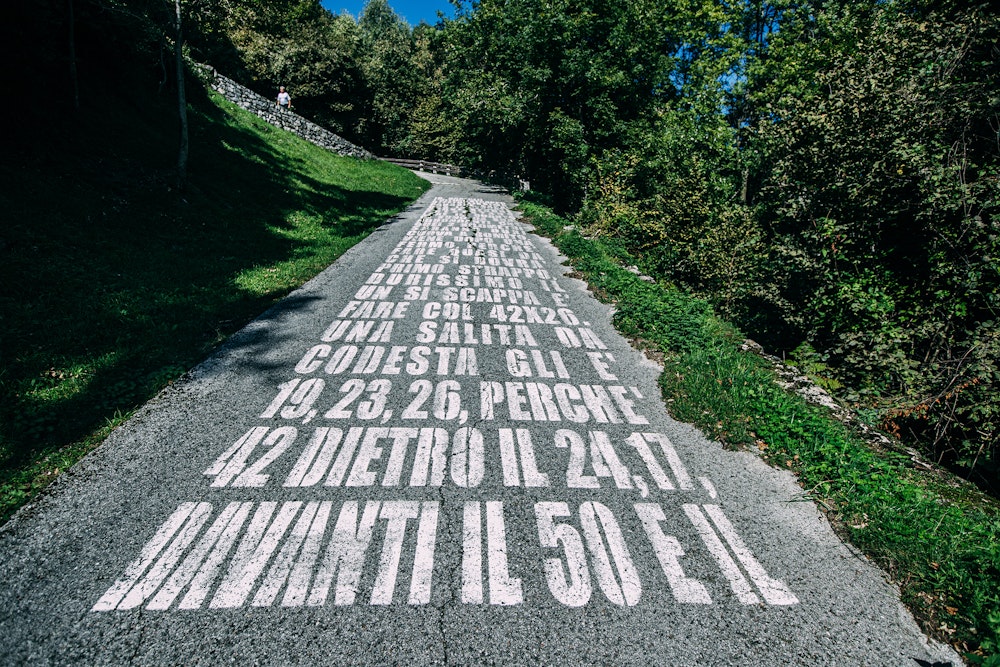
We finally reach Como and it’s time for a refuelling break: but again, we can’t overdo it because there are still some kilometres to go and, above all, we’ve still got the third and last climb of the day, the Civiglio, another classic Lombardy climb. We start the ascent from along the road to Brunate and, after via Tommaso Grossi, it’s a sequence of about ten hairpin bends that always remain around 10-11%. It’s a rather intense four kilometres and, since it’s also quite busy with cars, you need to be careful. We’re done with the climbs for today, but we still have another fifty kilometres to loosen up our sore legs.
In Albese con Cassano, in front of the Elementary Schools-between Via Don Sturzo and Via Rimembranze-we stop just for a moment at the monument of Fabio Casartelli, the racer, Olympic gold medallist in Barcelona in 1992, who, during a stage of the Tour de France, died from a fall three years later. Then, passing between the lakes of Alserio and Pusiano, we frame the serrated profile of Resegone on the horizon, cross Brianza again, and at Brivio climb over the Adda. We are back in the Bergamasca: we leave the lakes behind us and put the Orobie climbs in our sights. We will tackle them us on our third and final stage.
Today’s program first involves loosening our muscles on the Berbenno climb, then tackling the S. Antonio Abbandonato ramp, whose name, meaning ‘abandoned’, is fearsome in itself. Then we’ll descend into Val Brembana to climb back up Val Seriana to Nembro and, from there, pay homage to the climb par excellence of the people form Bergamo, the Selvino. Finally, we’ll continue to Passo di Ganda and descend Val Seriana again to Bergamo.
Breakfast was plentiful and now it’s time to burn it off. We cast a quick glance at the Rotonda di S. Tomè, an architectural jewel of Bergamo Romanesque architecture, and we too, hope to have a properly circular pedalling style today. After a stretch of valley floor in Valle Imagna, at the height of Ponte Giurino a road sign on the right says Berbenno: six kilometers of ascent for about 300 meters of elevation gain are ahead of us, with no particular difficulty. There are four or five hairpin bends, and the roadway is wide and well paved: the gradients are absolutely rideable with a few stretches of gentle slope. In short, it is just what we need as an appetizer for today.
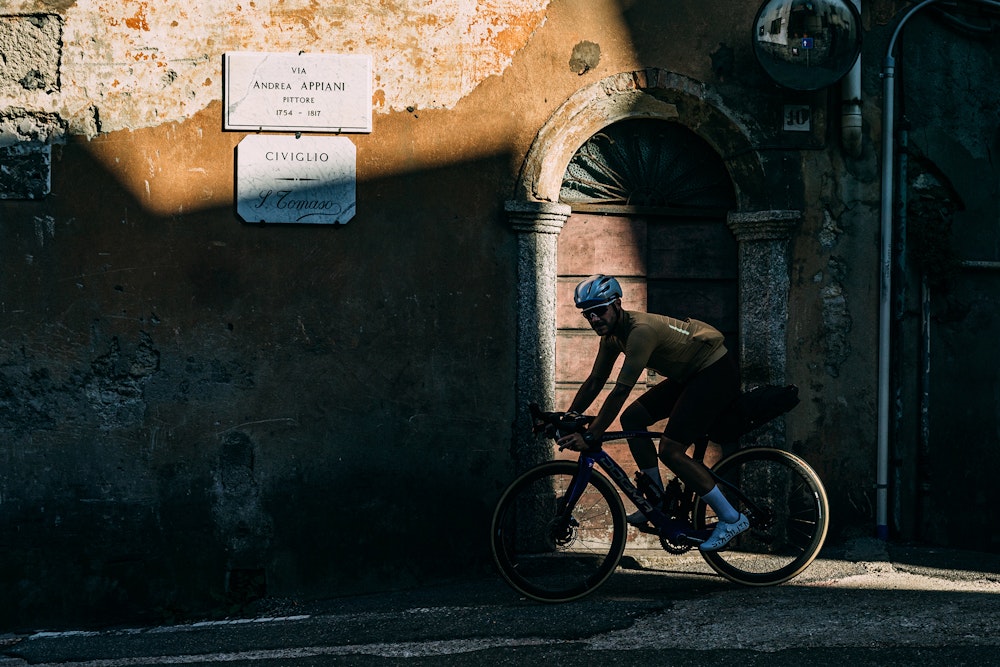
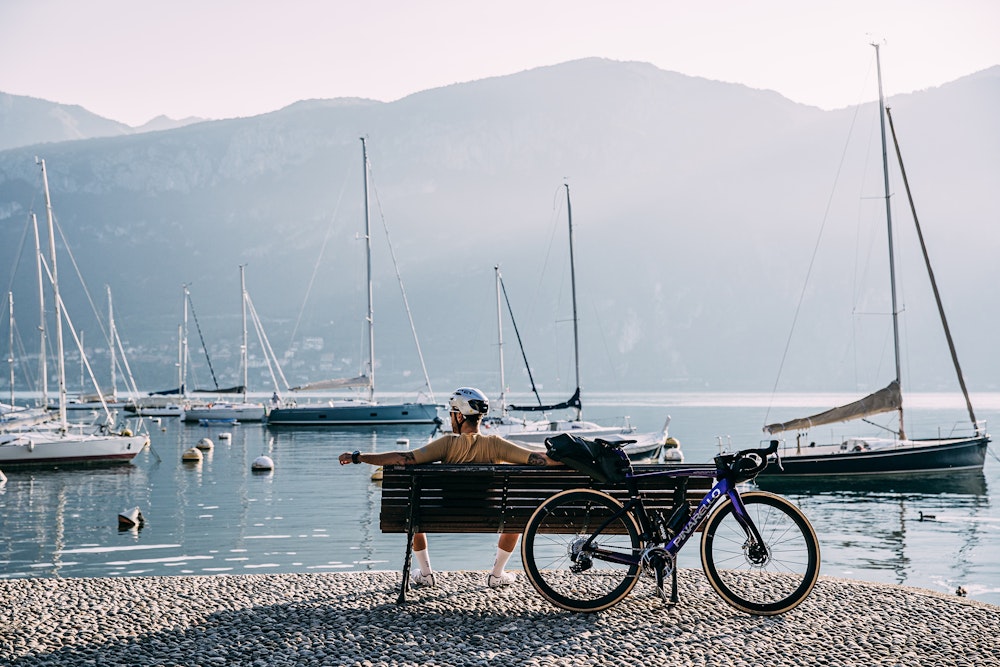
From the Forcella di Berbenno you descend in the direction of Laxolo and then to Brembilla. From here it’s a whole different story. The climb to the little church of S. Antonio Abbandonato, on the ridge between the Valli Brembilla and Brembana, is not very well known, but it can really hurt if it is not tackled with perseverance and self-denial. It’s a little less than six and a half kilometres, with an average gradient of just over 9 percent; so not impossible, but with four or five hairpin turns, at the height of the Malentrata locality, the kind that won’t let you breathe, that surge mercilessly with no chance of taking a wide turn in order to ease the suffering. When you reach the top, at about 1.000 meters above sea level, there is the little chapel that gives the climb its not-so-encouraging name, S. Antonio ‘the abandoned’: take a breath and turn around. The view of the mountains amply repays the effort made. A nose dive to Val Brembana, where, on the road back to the valley, in sequence we pass through Zogno and Sedrina, two towns that have left their mark on the history of Italian cycling.
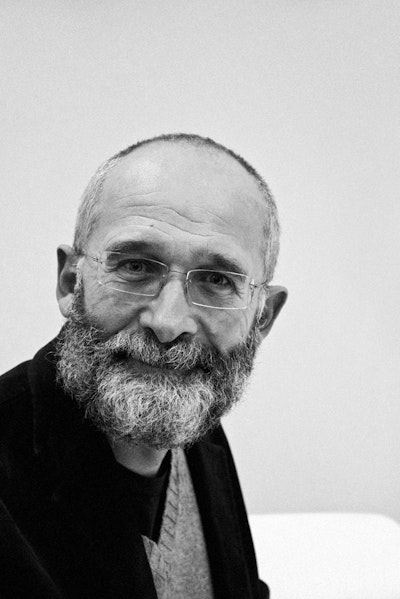
Texts
Gino Cervi
Photos
Francesco Rachello
Photos
Tornanti.cc
Cycled with us
Davide Caccia
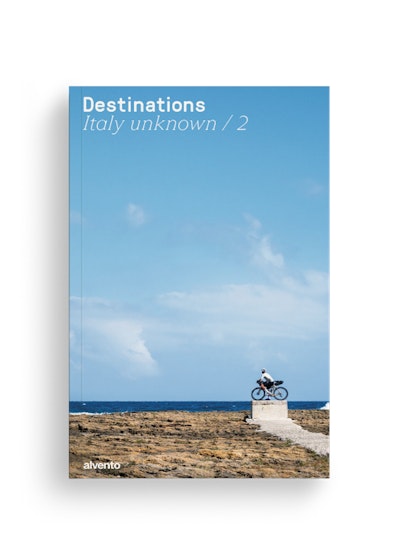
This tour can be found in the super-magazine Destinations - Italy unknown / 2, the special issue of alvento dedicated to bikepacking. 12 little-trodden destinations or reinterpretations of famous cycling destinations.
